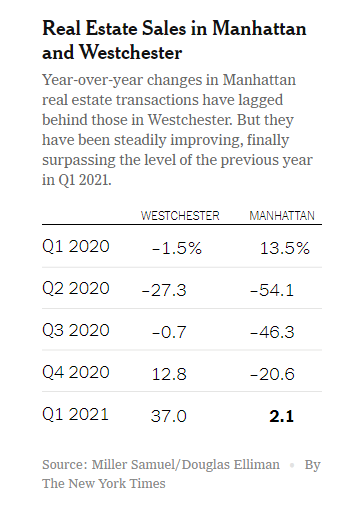did the suburbs kill the city real estate market? maybe not.
/By Michael Kolomatsky | Published on May 6, 2021
One of the most striking effects of the pandemic in New York was the outbound movement from Manhattan to less crowded suburban neighborhoods and the subsequent boom of the suburban real estate market. Real estate in the city and suburbs seemed to be a zero sum game.
“This outbound pattern created the idea that the suburbs had their day at the cities’ expense, and that cities were over,” said Jonathan Miller, of Miller Samuel, the appraisal company. “As it turns out, the assumption that there’s a binary relationship between city and suburbs isn’t quite right, as measured by sales activity.”
Mr. Miller contributed data for this week’s chart, which provides a timeline of sales activity in Manhattan and the suburban county of Westchester, where activity is representative of that in other New York City suburbs.
By the end of the second quarter of 2020 — a couple of months into the pandemic market — sales in Manhattan had plummeted about 54 percent year over year. In Westchester, the drop in sales was about 27 percent. By Q3, six months into the pandemic, Manhattan sales had crept upward, about 46 percent lower compared with a year earlier, while Westchester’s were well on the rise, within 1 percent of the previous year’s levels. By Q4, the Westchester sales had surpassed the previous year by about 13 percent, while Manhattan sales were 21 percent lower.
“It’s an optics problem,” answered Mr. Miller. “Companies haven’t called their employees’ back yet. Think about Midtown office towers — 80 percent empty, and they support the street-level retail. So when a camera pans over Times Square, it’s all boarded-up stores. But if you did the same thing on the Upper East Side, while it’s not normal, you have people walking around all over the place, outdoor dining …”
Sales are one thing, but prices matter too. Median sale prices in Westchester during Q1 2021 were 10.8 percent higher year over year, while in Manhattan they were up just 1.4 percent, an increase driven by larger and higher-priced units, according to Mr. Miller. “Considering that,” he said, “prices are generally down 5 to 7 percent pre- vs. post-pandemic lockdown.” But those low prices may not last. “Activity leads pricing, and the activity is there.”



